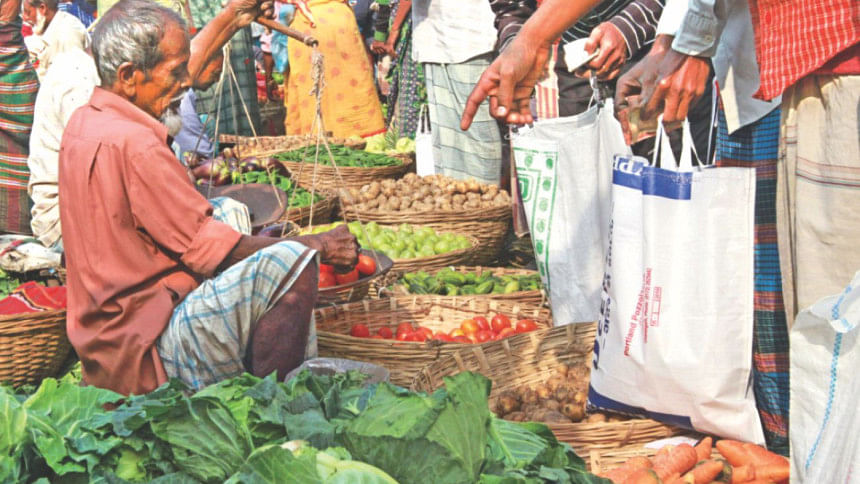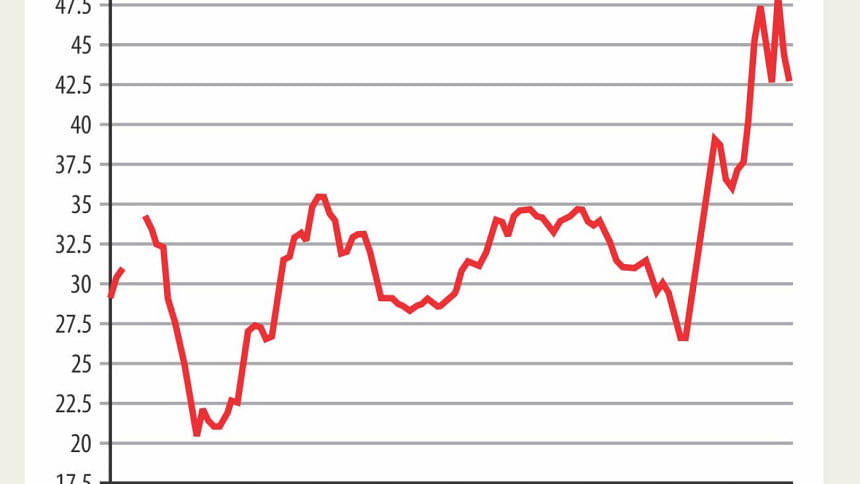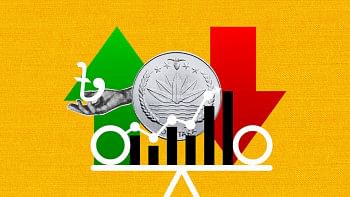2017 marked by consumers' woes

Since early morning yesterday, Shaikh Masum Bellah has been recollecting the year that just passed by and the factors that affected his and his family's wellbeing.
And one such event was the spiralling prices of rice and the other essential commodities in 2017.
"As consumers, we had a painful year. We had to spend almost double of what we spent the previous year," said Bellah, who works as manager of a shrimp wholesale depot at Rupsha, Khulna.

"Rice became dearer. Most of the vegetables were also beyond the reach of common people. Onion prices still remain high," said the 40-year-old, giving a rough outline of the rise in the cost of his daily shopping basket.
Consequently, many low and fixed-income families like Bellah's had to shelve their plans to buy material things like clothes or furniture because of the high prices of essentials.
Many had to borrow to manage the necessities as income did not increase in line with the spiral in living costs, particularly the price of foodstuff.
"So, it was really a very tough year for consumers," said Bellah, the sole breadwinner in a family of six.
Inflation, which is a measure of the consumer prices of a basket of commodities, began to rise from January last year after dipping to 5.03 percent in December 2016.
In October 2017, inflation stood at 6.4 percent, according to data from the Bangladesh Bureau of Statistics.
Analysts linked the spiral to the food price hike in 2017, mainly of the staple rice.
For example, the retail price of a kilogramme of coarse rice was Tk 35.84 in January this year in Dhaka city, according to the Food and Agriculture Organization.
The price of the coarse grain, mainly consumed by the low-income families, hit Tk 47.78 in September in Dhaka city for crop damage from recurrent floods and depleted public stocks, the FAO data shows.
Prices began to rise early this month once again after a marginal decline in September following increased imports upon cutbacks on import duty on the staple to 2 percent.
Yesterday, the retail prices of coarse grain was Tk 44-46 per kilogramme, 6 percent higher from a month earlier and 23 percent from a year earlier, according to data collected by the state-run Trading Corporation of Bangladesh.
The prices of medium and fine grains yesterday were 22 percent and 30 percent higher year-on-year respectively.
The overall cost of living has risen about 7-8 percent in 2017 from a year ago, said Humayun Kabir Bhuiyan, general secretary of the Consumers Association of Bangladesh.
"Consumers suffered in 2017 for occasional increase in the prices of key commodities and services," he said, while also citing the increase in the prices of electricity and gas.
"Not only the poor and low-income people, we also had to bear the brunt of the high prices," he said, adding that the government tried to curb the price hikes but could not succeed fully.
He echoed Bellah: people employed in the private sector did not see a rise in their income in line with the increase in the cost of living.
"We did not notice a surge in new employments during the outgoing year. In many instances, people lost jobs. Income and employment did not rise to that extent," he added.
Citing the Labour Force Survey 2016 released by the BBS this year, Zahid Hussain, lead economist of the World Bank's Dhaka office, said data reflects a significant slowdown in job creation since 2013.
Bhuiyan thanked the government for not implementing the new VAT law that seeks to apply 15 percent uniform VAT on goods and services, doing away with the multiple rates.
"The imposition of a flat rate would have had a negative implication for us," he said.
Quazi Shahabuddin, former director general of the Bangladesh Institute of Development Studies, said the increase in price of rice adversely affected the food security of the poor and low-income people.
"Rice prices rose to a high level partly because of natural disasters and partly for delayed response by the government."
He went on to cite the reduction of import duty twice to increase the supply of the grain and augment public stocks as an example of the government's not too brisk response.
"The duty could have been reduced earlier to curb spike. Had this been done, the sufferings of the low-income people would have been less."
It appears that the government responses were delayed from a sense of complacency because they did not see any crisis in recent years, Shahabuddin said.
Foodgrain stocks at public godowns dipped to as low as 5.61 lakh tonnes, including rice which reached 2.45 lakh tonnes in May, one of the lowest in recent years.
The government started importing in the second half of the year to replenish stocks to intervene in the market and slashed duty to facilitate private sector imports. On December 27, cereal stock was 7.67 lakh tonnes. Of that, stock of rice was 4.73 lakh tonnes.
Rice imports by both public and private sector rose to 15 times year-on-year to 21.55 lakh tonnes in July-December of the current fiscal, according to food ministry data.
Yet, prices remain high for increased import costs and speculations that the ongoing Aman harvesting period was witnessing a reduction in yield.
BIDS DG KAS Murshid said the increased prices of rice have affected people's expenditure on non-rice items. "There is an adverse implication on dietary diversity and nutrition."
The year ended on a pessimistic note as various indicators such as exports and the performance of banking sector were not encouraging.
"Overall, it is giving rise to some concerns and worries," he added.
M Asaduzzaman, distinguished fellow of BIDS, said farmers received relatively better prices in 2017.
"Poor people suffered but the prices were not beyond their tolerable limit," he said, while forecasting the prices of cereal to drop once a bumper boro is harvested.
Economists suggested the government focus on bagging a record boro crop this year by ensuring timely availability of fertiliser, diesel and electricity as well as extension services to farmers' doorstep.
Bhuiyan also said he was expecting the government to be active enough to take measures to keep the prices stable ahead of the national elections.
"There is big difference in prices between the wholesale and retail markets. The government should monitor the market regularly and take steps to reduce the gap. This will be helpful for us."

 For all latest news, follow The Daily Star's Google News channel.
For all latest news, follow The Daily Star's Google News channel. 



Comments